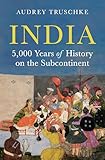India : 5000 years of history on the subcontinent / Audrey Truschke
Publication details: Princeton Princeton University Press 2025Description: xlx, 687 pages 24 cmISBN:- 9780691277424 (Paperback)
| Item type | Current library | Shelving location | Call number | Materials specified | Status | Notes | Barcode | |
|---|---|---|---|---|---|---|---|---|
 BOOKs
BOOKs
|
National Law School | General Stacks | 954 TRU (Browse shelf(Opens below)) | HB | Available | Recommended by Dr. Manpreet Singh Dhillon | 40338 |
Scholarly Conventions -
Starting Points -
1. Indus Valley Civilization, 2600-1900 BCE -
2. Ancient Migrants and Vedic Practices-
3. Building and Renouncing Cities, 550-325 BCE.-
4, Ashoka's Mauryan Empire -
5. Mahabharata: A Tale of Ancient India -
6. South Asians Traveling, 200 BCE-300 CE -
7. Inequality, Pleasure, and Power in Early India -
8. India in the World, ca. 700 CE -
9. Medieval South India -
10, Indo-Persian Rule and Culture, I190-1350 -
I1. The Long Fifteenth Century -
13. Ordinary and Extraordinary Lives in Early Modern -
12. Seeking God or Fame, 1500-1550.-
14. Religious Communities and Elite Culture, 1600-1650 -
15. Aurangzeb's Empire and Two Shudra Lineages.
16. Regional Flourishing, 1720-1780 -
17. Company Bahadur -
18. Sepoy Rebellion and Dawn of the British Raj -
19. Knowing India and Indians, 1860-1900 -
20. Indians on the Move, 1880-1920 -
21. Advocating for Independence, Nationalism, and Equal Rights.-
22. Dividing India in 1947.-
23. New Nation-States, 1947-1990.-
24. Everyday Life in Contemporary South Asia -
Afterword: Now -
Historiography -
Glossary -
Ilustrations and Sources -
Postscript and Acknowledgments -
Notes -
Bibliography -
Index.
Much of world history is Indian history. Home today to one in four people, the subcontinent has long been densely populated and deeply connected to Asia, Africa, Europe, and the Americas through migration and trade. In this magisterial history, Audrey Truschke tells the fascinating story of the region historically known as India--which includes today's India, Pakistan, Bangladesh, and parts of Afghanistan--and the people who have lived there. A sweeping account of five millennia, from the dawn of the Indus Valley Civilization to the twenty-first century, this engaging and richly textured narrative chronicles the most important political, social, religious, intellectual, and cultural events. And throughout, it describes how the region has been continuously reshaped by its astonishing diversity, religious and political innovations, and social stratification. Here, readers will learn about Hinduism, Buddhism, Jainism, Islam, and Sikhism; the Vedas and Mahabharata; Ashoka and the Mauryan Empire; the Silk Road; the Cholas; Indo-Persian rule; the Mughal Empire; European colonialism; national independence movements; the 1947 Partition of India; the recent rise of Hindu nationalism; the challenges of climate change; and much more. Emphasizing the diversity of human experiences on the subcontinent, the book presents a wide range of voices, including those of women, religious minorities, lower classes, and other marginalized groups. You cannot understand India today without appreciating its deeply contested history, which continues to drive current events and controversies. A comprehensive and innovative book, India is essential reading for anyone who is interested in the past, present, or future of the subcontinent
There are no comments on this title.
